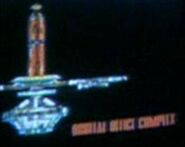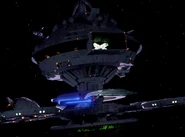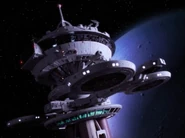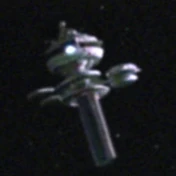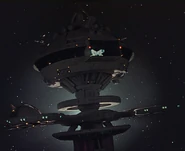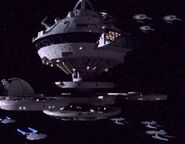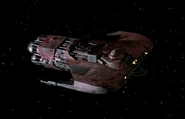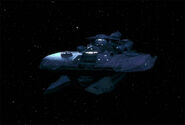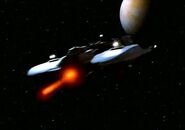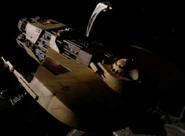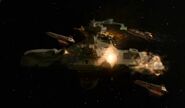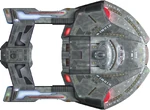(written from a Production point of view)
Chronological list of studio models in the Star Trek films.
| Studio models |
|---|
| The Original Series • The Animated Series • Films • The Next Generation • Deep Space Nine • Voyager • Enterprise • Discovery • Short Treks • Picard • Lower Decks • Prodigy • Strange New Worlds |
Star Trek: The Motion Picture[]
K't'inga class[]

- See main article: K't'inga-class model
Epsilon IX station[]

Epsilon IX station
- See main article: Epsilon IX station
Air tram[]

Air tram
- See main article: Air tram
Orbital office complex[]
This studio model was originally built as the orbital office complex for Star Trek: The Motion Picture. [1]
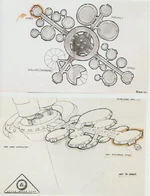
|
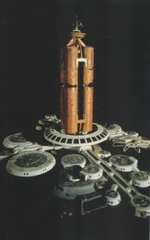
|

|
It was designed by Andy Probert, and in this form, was only used in The Motion Picture. Designing the office complex was the first design work that Probert did for the film. (The Art of Star Trek, p. 171; [2])
Construction on the complex began during the production of Star Trek: Phase II. According to Magicam's visual effects artist Jim Dow, "The first design for the space-office complex was by Mike Minor. It was composed of clusters of dodecahedrons. We worked on that for months, until we found out that it is literally impossible to cluster dodecahedrons – impossible mathematically. Mike could draw it – and it looked terrific – but we couldn't make it work. We have to use a simpler shape." Additionally, an more detailed model was required to allow it to have a "motion-picture quality." (Starlog #27, October 1979, p. 27-28; The Art of Star Trek, p. 171)
The model of this facility was filmed in the summer of 1978, on one of Douglas Trumbull's stages at Future General Corporation. (The Making of Star Trek: The Motion Picture, p. 206)
Though it only appeared in its original configuration for The Motion Picture, an okudagram of the complex, sketched by Doug Drexler, also appeared in Star Trek: Deep Space Nine and Star Trek: Voyager.
For budgetary reasons and a limited time schedule, and at the recommendation of producer Robert Sallin, ILM's supervising modelmaker, Steve Gawley, inverted the original model, took a few things off and added a few new things before rechristening it as the Regula I science station for Star Trek II: The Wrath of Khan. "It was quite cost effective," Gawley said, adding "it was this approach that prevailed throughout the project." (The Making of Star Trek II: The Wrath of Khan, p. 123; The Special Effects of Trek, p. 65; The Making of the Trek Films, p. 25; Trek: The Unauthorized Story of the Movies, p. 67)
It was reused in the same configuration, though at different scales, for several episodes of Star Trek: The Next Generation, before it appeared one last time in DS9, courtesy of stock footage from The Wrath of Khan.
The model would be modified one final time prior to the start of DS9 Season 6 to appear, initially, as Starbase 375, before making two subsequent appearances as other related station before the end of the season.
According to David Stipes, "all the lower tanks were removed, and it had been refurbished by Gary Hutzel and Tony Meininger." According to Hutzel, "I had seen it in storage [and] we brought it back because it was such a cool model, a really beautiful miniature." (Star Trek: Deep Space Nine Companion (p. 500)) It appeared one final time in an okudagram in VOY.
Additional sources[]
Earth spacedock[]
| Model variations | |
|---|---|

|

|
Star Trek: The Motion Picture |
Star Trek Generations |
- See main article: Earth spacedock
Cargo management unit[]

Work Bee
Star Trek: The Motion Picture, et al.
- See main article: Cargo management unit
Travel pod (23rd century)[]

Travel pod
Star Trek: The Motion Picture, et al.
- See main article: Travel pod model
Constitution II class[]

- See main article: Constitution II-class model (refit)
Surak[]

- See main article: Long range shuttle model
V'ger[]

V'ger
- See main article: V'ger
Star Trek II: The Wrath of Khan[]
Miranda class[]
| Model variations | |
|---|---|

|
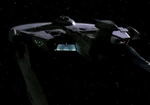
|
Star Trek II: The Wrath of Khan, et al. |
TNG: "Cause And Effect" |
- See main article: Miranda-class model
Star Trek III: The Search for Spock[]
Merchantman[]
This model was originally designed by Nilo Rodis and built by ILM to represent the Merchantman in Star Trek III: The Search for Spock. In Voyager, the ship appeared as both a physical model and CGI model.
Additional sources[]
Klingon Bird-of-Prey[]

Kruge's Bird-of-Prey
Star Trek III: The Search for Spock, et al.
- See main article: Klingon Bird-of-Prey
Spacedock One[]

- See main article: Spacedock type
Orbital shuttle[]

Orbital shuttle
Star Trek III: The Search for Spock, et al.
- See main article: Orbital shuttle
Excelsior class[]

- See main article: Excelsior-class model
Oberth class[]

- See main article: Oberth-class model
Star Trek IV: The Voyage Home[]
Whale Probe[]

Whale Probe
- See main article: Whale Probe
Star Trek V: The Final Frontier[]
Pioneer 10[]
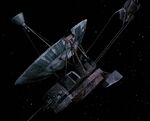
Pioneer 10
- See main article: Pioneer 10
Galileo[]

Galileo-type shuttle
Star Trek V: The Final Frontier, et al.
- See main article: Galileo-type shuttlecraft model
Star Trek VI: The Undiscovered Country[]
SD-103[]

SD-103 model in its original configuration
| Model variations | ||
|---|---|---|
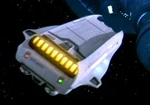
|

|

|
Star Trek VI: The Undiscovered Country |
TNG: "Relics" |
DS9: "Playing God", "Accession", "Trials and Tribble-ations", "Chrysalis" |

|

|

|
Star Trek Generations |
Star Trek Generations |
Star Trek Generations |
The studio model of the SD-103-type, built especially for The Undiscovered Country was purely an initiative of Industrial Light & Magic (ILM), the company contracted to do the visual effects for the movie, since scene 24 of the movie script did not foresee in one. The concept originated from the brain of ILM's Visual Effects Art Director Bill George, when he was conceiving a visual effects shot for the movie. He clarified, "When Kirk and the others head up to the spacedock to reboard their ship, we really wanted to open the film up and show the grandeur of space. Immediately I thought of 2001 – in particular, the docking sequence between the Orion space clipper and the double-wheeled Space Station One. I also got the bug in my mind to do an angle on the spacedock that hadn't been done before. I looked at at the model from all angles, and eventually ended up lying down on the ground to look up at it before I realized that was the perfect shot – it hadn't been done before, plus it was the natural angle of approach if you were coming up from Earth." George decided to beef out the shot with a new shuttle model. While Paramount Pictures had shuttle models available from the previous outings, The Search for Spock and The Final Frontier, George decided nevertheless to have a new one built. This was partly due of George being a consummate modelmaker (he had started out at ILM as such) and, though it was strictly speaking not his job anymore, he could not refrain himself from building another one, as studio model requirements were very light for ILM on this particular outing. All other models featured in the movie, including some on which George himself had previously participated in their builds, were reuses from earlier productions. He had John Goodson design one, and together they build the model, or as he has put it, "We designed and constructed a new shuttlecraft model just for this shot, the only new model we got to do this time. It was done very quickly – in a week – and was about sixteen inches long." (Cinefex, issue 49, p. 48)
George and Goodman embellished the model by endowing the ventral side with several add-ons that had their origins in AMT/Ertl Star Trek model kits. So did the model feature two nacelle caps with Bussard collectors of the Enterprise-D model kit (No. 6619) as well as warp nacelle from the Romulan warbird model kit (No. 6858). Unfortunately for them, no dorsal views were seen of their model in the movie, though the tips of the Enterprise Bussard collectors were.
The model made a reappearance in Star Trek Generations as two shuttlecraft from the USS Farragut, sent down to the surface of Veridian III to pick up the survivors of the crashed USS Enterprise-D. However, since the actual model was by that time already modified and altered, the shot of the shuttle in flight was actually stock footage from The Undiscovered Country, but flopped and altered in post-production by adding the blue Farragut signage. The one seen on the saucer of the crashed Enterprise-D was not even a model but part of the matte painting that was done at ILM for the scene. (Cinefex, issue 61, p. 77) Still, a second model was in effect constructed for the movie, albeit a tiny one. It was built to go with the modified NAR-30974 spacedock model, carried over from The Motion Picture, as atmosphere, and it could be seen, though only just barely, parked, when the USS Enterprise-B left spacedock at the beginning of the movie.

Dan Curry touching up the USS Jenolan model for its use in "Relics" at Image G

|
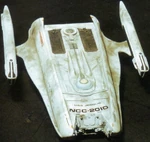
|

|

|
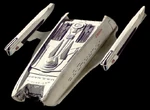
|

|
In between the two movies, the original model itself was heavily modified by Greg Jein, who added warp engines to the model, with components derived from the Constitution-class and Miranda-class models, and given the look of a full starship with several decks, to appear as the Sydney-class. (Star Trek VI: The Undiscovered Country (Special Edition), text commentary; TNG Season 6 DVD-special feature, "Departmental Briefing Year Six - Production") Jein also extensively refurbished the dorsal side by endowing the original smoother surface by adding the bridge and deflector crystal assembly modules, as well as the ventral side by removing George's original add-ons and replacing them with add-ons in order to convey the sense of the model being a larger scaled ship. The now Sydney-class model initially appeared as USS Jenolan, though Jein or one of his modelers actually mislabeled the ship as "Jenolin", in "Relics", where the misspelled name however, was never clearly discernible (that was until 2014, when the episode was remastered and where it could be discerned that the name was not digitally corrected). Later, the model appeared, flipped over and relabeled, as the USS Nash in the Star Trek: Deep Space Nine episodes "Playing God" (season 2), "Accession" (Season 4), "Trials and Tribble-ations" (Season 5) and "Chrysalis" (Season 7). As usual with the television appearances of studio models, footage of this model for its appearances in both series was shot at Image G, the company were Erik Nash worked as motion control camera operator, and whose name was given to the model for its Deep Space Nine appearances. (Cinefantastique, Vol 25 #6/Vol 26 #1, p. 102) It's accompanying registry number though, "NCC-2010-5", harkened back to the one the model was endowed with in its previous use as the Jenolan, "NCC-2010", and as far as in-universe usage of the Starfleet registry numbering system went, an odd one at that, as this was the only time that a ship was given a number of another class vessel appended with what appeared to be a follow number. Actually, since Deep Space Nine was already in pre-production at the time of "Relics", the modified model was seriously considered by Production Designer Herman Zimmerman and the producers to serve as the regular runabout shuttlecraft for the namesake station. Yet, it was ultimately decided to pass over the model in favor of the Danube-class, though the model served as a starting point for its design. (Star Trek: The Magazine Volume 2, Issue 10, p. 54)
The Sydney-class model (measuring 16½" × 11" × 4") was listed as Lot 704 in the 40 Years of Star Trek: The Collection auction with an estimated sale price of US$4,000 - $6,000; it sold on 7 October 2006 for US$22,000 ($26,400 with premium). The tiny SD-103 type model was of course part of the spacedock model, which sold as Lot 995 in the same auction on the same day for US$8,000 ($9,600 with premium), originally estimated at US$3,000 - $5,000. That model was acquired by American collector Adam Schneider, who managed to acquire several models from the auction. [3]
Star Trek Generations[]
Whorfin class[]

- See main article: Whorfin class
Amargosa observatory[]
| Model variations | |
|---|---|

|

|
Star Trek Generations |
DS9: "Destiny" |
- See main article: Amargosa observatory
Star Trek: First Contact[]
Sovereign class[]

- See main article: Sovereign-class model
Akira class[]
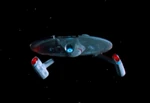
- See main article: Akira-class model
Norway class[]

Norway class
- See main article: Norway class
Saber class[]

- See main article: Saber class
Steamrunner class[]
| Model variations | ||
|---|---|---|

|

| |
Star Trek: First Contact, et al. |
ENT: "Storm Front, Part II" |
PIC: "Assimilation" |
The Steamrunner-class starship was designed by Alex Jaeger at ILM. The USS Appalachia, featured in First Contact, was apparently intended to be named "Streamrunner" originally, as based on the name appearing in Jaeger's sketch of the revamped "USS Streamrunner," dated 4 April 1996. This name was a homage to a song by the band Fold Zandura. The reasoning for the name change to Appalachia is unknown, and was subsequently adapted (or adopted) by the Star Trek Encyclopedia and Star Trek: Deep Space Nine Technical Manual, but the original name, albeit misspelled, was retained as class designation.
Jaeger, in far more detail, recalled in 2009,
"Here's a bit of background on the Steamrunner: As one person pointed out, it was originally to be called the StReamrunner. This was the name of a song from a band called 'Fold Zandura' (formerly 'Mortal') It had a sci-fi feel to it and I thought it made a cool ship class name. But somewhere in the process the 'R' got dropped in one of the approval pages and it became the Steamrunner, which is still kinda cool retro-steampunk sounding. So the name stuck. Also on the design, it is actually the merging of two different designs I did. The front saucer section of one ship combined with the catamaran nacelles and boom section of another. The boom section of the second ship was then flipped upside down so the deflector was underneath. The first design had a secondary hull, but instead of struts to hold the nacelles, they where instead mounted to the saucer section and then cowled over. There was even a 3rd version with 4 nacelles, two on the top and two more attached to the lower secondary hull. "The second design was more to my liking, it was a bit more 'automotive' in its design shapes. It featured the catamaran nacelles, but instead of being mounted on top of the saucer, they were mounted underneath and the saucer sort of bent around them. The Deflector dish boom was then mounted more like the boom on the Akira class only this wasn't a weapons pod per say. In the end I was asked to combine the front of #1 with the tail of #2 and after some adjustments, bam the Steamrunner as it appears in First Contact. Some of the more angular features were also a result of the rough model as well. So the more rounded #2 design would've been less economical from a VFX standpoint too." [4](X)
The model was rendered as a computer-generated model and built by Larry Tan and Paul Theren. According to designer Jaeger, the software used to build the models consisted of software package combo, elaborating, "(...)ILM was using Electric Image for animation and Form-Z for the models of these ships back then." [5](X) A year later ILM was requested by Paramount Pictures to hand over their models made for Star Trek: First Contact, among them the Appalachia, to Digital Muse in preparation for use in the upcoming Star Trek: Deep Space Nine episode "Sacrifice of Angels". Due to Muse's use of different software, the model had to be largely re-rendered in LightWave 3D and was remapped at a higher resolution in the process, but was completed early enough to be already showcased in "Call to Arms". [6](X)
Visual Effects (VFX) Supervisor David Stipes said that an overall length of 800 feet (243.8 meters) was generally used for its Deep Space Nine on-screen appearances. [7]
The apparently unaltered model made a near unnoticeable, but surprising nonetheless, reappearance as a presumably unrelated – considering the anachronistic nature of its reappearance – 22nd century class of ship used by the United Earth Starfleet hundreds of years before the Steamrunner class, in the Star Trek: Enterprise season four episode "Storm Front, Part II".
The model was again re-rendered in LightWave 3D by Fabio Passaro for use in its 2015 outing of the Star Trek: The Official Starships Collection from Eaglemoss Collections, featuring an even higher polygon count, higher resolution textures, and updated hull detailing, including the addition of visible fore and aft torpedo launchers, two shuttlebays on the aft part of the saucer, and impulse engines. [8] His model version was later added as a graphic in the Star Trek Encyclopedia (4th ed., vol. 2, p. 325), replacing graphics of the class, created by Doug Drexler in the more basic Adobe Illustrator software for previous editions and which were originally featured in the above mentioned Deep Space Nine Technical Manual.
Eighteen years after its last onscreen appearance in the 2004 Enterprise episode, the design turned up again onscreen in the Star Trek: Picard season two episode "Assimilation" as the CSS Leyton. This however, was neither the Muse model, nor the Passaro model but rather a newly constructed CGI model. It concerned a model created for use as a playable ship in the Star Trek Online computer game, that had gone live in the intervening years, and was a build by Donny Versiga, one of the game's early mainstays. [9](X) In a unique collaboration between Cryptic Studios, the game's developer, and the creative minds behind Picard, the game CGI version became one of several, put at the disposal of the live-action production for onscreen use. [10] The necessary adaptions for its ultimate onscreen use were performed at the franchise's own in-house VFX department under the auspices of department heads Jason Zimmerman (Supervisor), Shawn Ewashko (Production Manager), and Brian Tatosky (Associate Supervisor). [11][12]
The role of Passaro's model was not entirely played out though, as it became the basis for the adaption into the scaled-down Sabrerunner-class which became featured as the USS Passaro in Star Trek: Lower Decks's fourth season episode "Old Friends, New Planets". [13][14]
Borg sphere[]

Borg sphere
- See main article: Borg sphere model
Sovereign-type escape pod[]

Sovereign-type escape pods
- See main article: Sovereign-type escape pod
Phoenix[]

Phoenix
- See main article: Phoenix
T'Plana-Hath[]

- See main article: T'Plana-Hath-type model
Star Trek: Insurrection[]
Ru'afo's flagship[]

- See main article: Ru'afo's flagship model
Federation mission scoutship[]

- See main article: Federation mission scoutship model
Type 11 shuttlecraft[]

- See main article: Type 11 shuttlecraft model
Federation holoship[]

- See main article: Federation holoship model
Son'a battle cruiser[]

- See main article: Son'a battle cruiser model
Son'a collector[]

- See main article: Son'a collector model
Cousteau[]

- See main article: Cousteau model
Son'a shuttle[]

- See main article: Son'a shuttle model
Star Trek Nemesis[]
Argo[]

Argo
- See main article: Argo
Scimitar[]

- See main article: Scimitar
Scorpion class[]

- No information yet.
Valdore[]

- See main article: Valdore type
Star Trek[]
These models were computer-generated at ILM. This list is based on one generated at Ex Astris Scientia. Many of these ships were designed by Ryan Church.
USS Kelvin[]

- See main article: Kelvin type
Narada[]

- See main article: Narada
Kelvin-type shuttlecraft[]

- See main article: Kelvin-type shuttlecraft
Constitution-class (alternate reality)[]

- See main article: Constitution class (alternate reality)
Military shuttle[]

- See main article: Military shuttle
Jellyfish[]

- See main article: Jellyfish
Class III neutronic fuel carrier[]

- See main article: Class III neutronic fuel carrier
Klingon Warbird[]

Klingon Warbird
- See main article: Klingon warbird
Moore-type shuttlecraft[]

- See main article: Moore-type shuttlecraft
Starbase 1[]

Starbase 1
- See main article: Starbase 1
USS Armstrong[]

USS Armstrong
- See main article: Armstrong type
USS Newton[]

USS Newton
- See main article: Newton type
USS Mayflower[]

A Federation starship
- See main article: Mayflower type
Starship class #1[]

Unknown starship type
- This starship class was seen briefly when the Gilliam approached Spacedock 1.
Starship class #2[]

Unknown starship type
- This starship class was seen briefly when the Gilliam approached Spacedock 1.
Starship class #3[]

Unknown starship type
- This starship class was seen briefly when the Enterprise warped away from Spacedock 1.
Vulcan escape craft[]

Vulcan escape ship
Constitution-type escape pod[]

The escape pod
- See main article: Constitution-type escape pod (2250s)
Star Trek Into Darkness[]
Takayama-type shuttlecraft[]

Takayama-type shuttlecraft
- See main article: Takayama-type shuttlecraft
Jumpship[]

Federation Jumpship 208
- See main article: Jumpship
Workbee (alternate reality)[]

Workbee
- See main article: Workbee (alternate reality)
K'normian trading ship[]

The K'normian trading ship
- See main article: K'normian trading ship
D4-class[]

D4 class
- See main article: D4 class
Io Facility[]

Io Facility
- See main article: Io Facility
Cargo shuttle[]

A cargo shuttle
- See main article: Cargo shuttle
Dreadnought-class[]

USS Vengeance
- See main article: Dreadnought class
Garbage barge[]

A garbage barge
- See main article: Garbage barge
Star Trek Beyond[]
Starbase Yorktown[]

Starbase Yorktown
- See main article: Yorktown
Yorktown satellite[]

Yorktown satellite
- See main article: Yorktown satellite
Kalara's escape pod[]

Kalara's escape pod
- See main article: Kalara's escape pod
Yorktown sentry ships[]

Yorktown sentry ships
- See main article: Yorktown sentry ship
Swarm ship[]
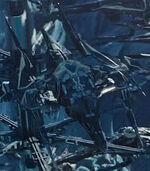
Swarm ship
- See main article: Swarm ship
Krall's command ship[]

Krall's command ship
- See main article: Krall's command ship
Freedom-class[]

Franklin type
- See main article: Freedom class
Salcombe-type[]

Salcombe type
- See main article: Salcombe type


